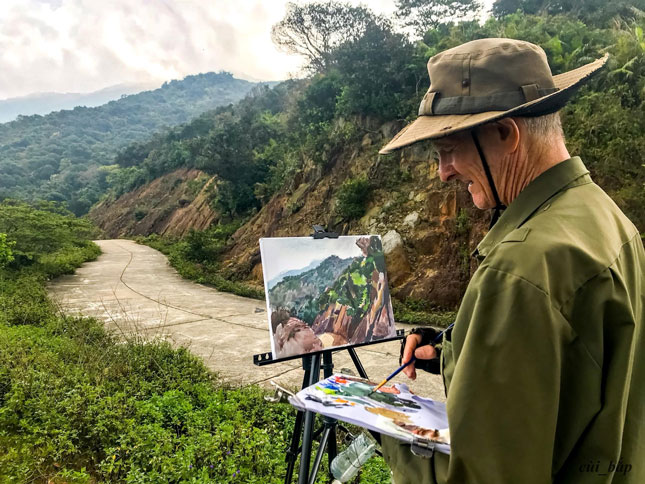Son Tra Peninsula very attractive to visitors
About 10 km northeast from the centre of Da Nang, the Son Tra Peninsula is considered to be a precious natural gift and a ‘green lung’ for the city.
 |
| Mr Paul is drawing on the Son Tra Peninsula |
Over recent years, the peninsula has become more inviting to both domestic and foreign visitors thanks to its pure air, and many popular tourist attractions such as the thousand-year-old banyan tree, the Ban Co (Chess Board) Peak, the Vong Canh Hills, a radar station, and the magical Bodhisattva Avalokitesvara statue at the Linh Ung Pagoda.
46-year-old Nguyen Thi Dieu Nguyen from Ha Noi visited Da Nang for several days at the invitation of her childhood friend living in the city.
In the early morning of the first day in the seaside city, Mrs Nguyen and her friends enjoyed the dawn on the peninsula. They were absolutely fascinated by the pure cool air and beautiful natural scenery there.
Mrs Nguyen remarked “Enjoying the dawn, admiring colourful flowers, and listening to the sounds of birds singing in nearby trees whilst sipping a cup of coffee are the most interesting experience of my life. I am very interested in going for a walk under trees, riding on winding roads with extensive greenery and beautiful wildflowers along the roads, and sitting on a rock to admire the beauty of the beaches.”
Like Mrs Nguyen, many Son Tra lovers have showed their sentimental attachment to this site in their own distinctive way.
Mr Paul from Australia said that he felt in love with the peninsula as he set foot in this venue for the first time. From then, the 80-year-old man usually rides his bicycle to the peninsula to draw or take amazing photos of the city from above, red-shanked douc langurs and birds there.
According to incomplete statistics from the Department of Tourism, the peninsula welcomes a daily average of over 1,000 visitors. The majority of them visit the Linh Ung Pagoda, the Dong Dinh Museum and the banyan tree, as well as enjoy delicious seafood at the Bai Rang and Da Den (Black Rock) areas.
Local freelance tour guide Nguyen Minh Hung said that many young travellers prefer to book tours to the peninsula by bicycles or motorcycles in order to explore the site’s beautiful natural landscapes, conquer nature, and discover rich biodiversity there. Riders are very impressed with towering cliffs on one side, and the beautiful blue of sea to the other on some sections of the road.
Ms Nguyen Thi Kim Lien from the city-based Viet Nam Tourism Joint Stock Co (Vitours) said that the number of tours to the peninsula is still modest because this tourist site is facing a shortage of some basic services for visitors such as public toilets, transit stations, eating and drinking areas, and rest stops.
Deputy General Director of Vitours Le Tan Thanh Tung underlined the importance of effectively exploiting such tourism potential, and conserving the natural habitat of plant and animal species there.
He stressed the necessity for the city government to grant permission for a travel agent to explore tourism and protect this site in a sustainable development manner.
Special attention should be paid to advertising the peninsula to international tourists, developing more services at this site, and enhancing the management work here.
Mr Bui Van Tuan, the Manager of the Scientific Research Department of the Da Nang-based GreenViet Biodiversity Conservation Centre, said that recent years have seen an increasing number of visitors to the peninsula. As a result, the precious nature is being damaged gradually by litter thrown by mindless people.
He, therefore, proposed that guardrooms should be established at 3 entrance gates to the peninsula to increase the monitoring of visitors, as well as control the length of their stays.
Importance should be attached to upgrading the Son Tra Nature Reserve into a national walking garden in a bid to promote the tourism development, and ensure biodiversity conservation.
Heed should be paid to developing friendly eco-tourism products, including tours to discover the unique beauty of the red-shanked douc langurs, and to go for a walk under trees, as well as educational tourism for pupils from the city and neighbouring localities.